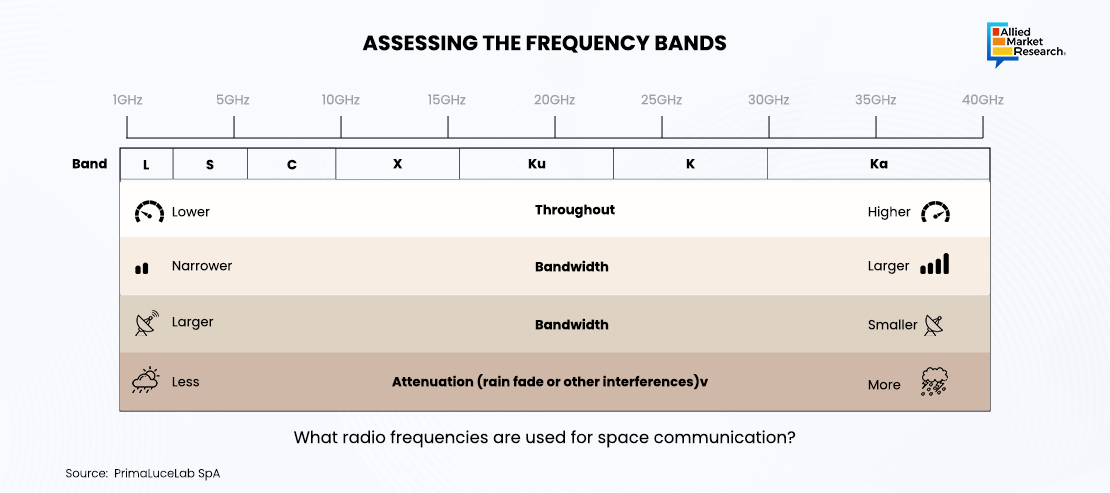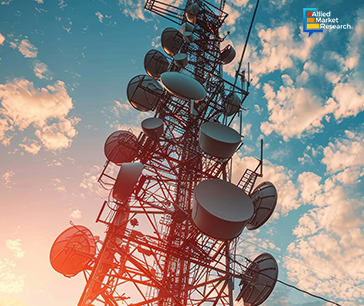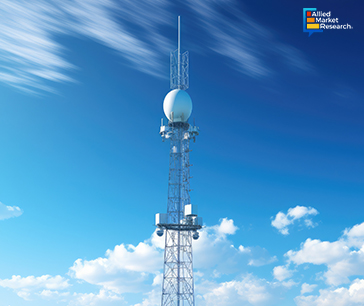Table Of Contents

Lalit Janardhan Katare

Akshata Tiwarkhede
Satellite Antenna: A Comprehensive Guide to Communicate beyond Skies

Satellite antenna serves as an integral component of satellite communication systems that are designed to operate at microwave frequencies, ranging from 1 GHz to 40 GHz. These devices facilitate the reception and transmission of signals between satellites orbiting earth and ground stations, enabling different applications, including television broadcasting, internet services, weather forecasting, and GPS. Satellite antennas are used to concentrate the satellite’s transmitting power toward a designated geographical region on earth and avoid interference from undesired signals that will deteriorate the overall quality of the signal.
Antennas that are used in satellites are selected depending on the requirements of their physical configurations having low volume, low installation cost, and high antenna frequency gain—the intensity at which an antenna propagates its signal in a particular direction. Antennas receiving signals can be directional/bidirectional as well as omnidirectional in nature. Directional antennas transmit/receive signals only from a particular direction and have a radius of about 45-90 degrees. However, omnidirectional antennas transmit/receive RF signal equally from all directions and provide a 360-degree radiation pattern.
How Communication Reaches beyond the Sky?
The operation of a satellite antenna involves both the transmission and reception of signals.
Transmission
The process of signal transmission via satellite involves several sequential steps, each playing a crucial role in ensuring efficient communication. Initially, the signal is generated by the transmitter and modulated to carry the required information, whether it is data, voice, or video. Following this, the baseband signal undergoes frequency up-conversion, wherein it is converted to a higher frequency suitable for satellite transmission. This conversion process entails mixing the baseband signal with a carrier frequency. Subsequently, the upconverted signal is amplified using a high-power amplifier to ensure it can effectively traverse the long distance to the satellite. Once amplified, the signal is directed to the feed horn, which serves to transmit it toward the parabolic reflector. The reflector then focuses the signal into a narrow beam and directs it precisely toward the satellite. Upon reaching the satellite, the signal is received, amplified once more, and retransmitted back to earth, often to multiple ground stations. This intricate process ensures the successful transmission of signals over vast distances via satellite, enabling seamless communication and data exchange across the globe.
Reception
In the process of receiving signals from satellites, ground stations play a pivotal role in ensuring effective communication. It begins with the ground station's parabolic reflector collecting the signal transmitted by the satellite. This collected signal is then directed to the feed horn, which gathers and focuses it, subsequently directing it to the low noise block. The low noise block’s primary function is to amplify the weak signal received from the satellite and convert it to a lower frequency for easier processing. Following this, the received signal undergoes frequency down-conversion, where it is converted back to its baseband form, ready for further processing. Subsequently, the baseband signal is demodulated to extract the transmitted information, which can then be processed and utilized as needed. This comprehensive process ensures that signals received from satellites are effectively captured, amplified, and converted for seamless communication and data exchange at ground stations.

The above image showcases the radio frequency bands used in space communication, ranging from L band (~1 GHz) to Ka band (~27-40 GHz). The throughput rate increases from lower band (L Band) to higher band (Ka band). Meanwhile, the bandwidth increases with the increase in frequency, Moreover, the antenna size decreases with higher frequency, thus resulting in the need for higher antenna for lower bands. Higher frequency bands like Ku, K, and Ka offer better throughput and smaller antennas but are more susceptible to interference, while lower frequency bands like L, S, and C have larger antennas and less interference but lower throughput and narrower bandwidth. This balance of properties is critical for choosing the appropriate band for specific space communication needs.
Advancements in Satellite Antenna Technology Redefining Connectivity
One significant advancement in this domain is the emergence of high throughput satellites, designed to deliver substantially more data compared to traditional satellites. High throughput satellites employ multiple spot beams instead of a single wide beam, thereby increasing the capacity and speed of satellite communication services, making them ideal for applications requiring high bandwidth and data rates. Moreover, the utilization of higher frequency bands, such as Ka-band (26.5-40 GHz), represent another notable development in satellite antenna technology. These frequency bands enable higher data rates and increased bandwidth, catering to the escalating demand for data-intensive applications. Ongoing research in even higher frequency bands, like V-band (40-75 GHz), further underscores the industry's commitment to pushing the boundaries of satellite communication capabilities.

The field of satellite antennas is undergoing a continuous evolution driven by the quest for enhanced performance, efficiency, and versatility to meet the growing demands of modern communication and technology. For instance, in December 2020, a leading supplier of antennas for aeronautical connectivity, QEST Quantenelektronische Systeme GmbH (QEST) announced a next-generation, powerful airborne Ka-Band antenna. This antenna is developed for maximum throughput in receive and transmit. Along with the advantages of a newly introduced receive booster, Ka-Band antenna exhibits all benefits of mechanically steered airborne antennas. This combination makes the antenna superior as compared to any other single beam phased array antenna system, exceeding transmit spectral efficiency of existing single beam phased array antennas by a factor of up to 10. Thus, QEST’s Ka-Band system is one of the most powerful antennas available in the market, enabling an optimized and more cost-efficient utilization of satellite spectrums.

Furthermore, advancements in phased array technology have led to the development of electronically steerable antennas, marking a significant milestone in satellite antenna innovation. These antennas can swiftly and precisely adjust their beam direction without the need for moving parts, making them indispensable for applications requiring rapid and dynamic beam steering, such as those found in mobile and airborne platforms. Furthermore, the trend toward miniaturization and integration is reshaping the landscape of satellite antenna design. There is a growing demand for smaller and more integrated solutions, driven by applications like small satellites (CubeSats) and portable communication devices. Innovations in materials and fabrication techniques are facilitating the development of compact, lightweight, and highly efficient satellite antennas to meet these evolving needs.
In addition, the integration of AI and ML algorithms into satellite antennas has given rise to the concept of smart antennas. These antennas can dynamically optimize signal reception and transmission, adapting to changing environmental conditions such as interference and signal blockage. By leveraging AI and ML, smart antennas enhance overall performance, ensuring reliable and efficient communication in diverse operating environments.
Case Study: Providing a Mobile Solution
A client approached Challenger Communication—a keymanufacturer of satellite antenna systems—with the need for antennas that would be deployed on rough terrains for patrolling and maintaining border security. It was clear that the client needed a mobile solution, and the company delivered with five very specific, quick-to-deploy, trailer-mounted transmit/receive system. The company’s 3.8 meter all-aluminum offset reflector was the proposed component.
These antennas were bound for deployment on Indian borders, and the project completion time was limited. Working within the tight deadline, the company Challenger Communication completed the project by delivering the required five antennas. After manufacturing, the company conducted the performance proofing at its testing location wherein it tested live on Galaxy 18 satellite at 123° West. Post completion of the testing, Challenger Communication delivered the required communication antenna to the deployment destination.
Challenger Communication's swift and efficient delivery of the trailer-mounted antenna systems, rigorously tested on Galaxy 18 satellite, ensured robust and reliable communication capabilities for border security operations on Indian terrain, showcasing the company's commitment to quality and at the same time ensuring the smoother application of military antenna for border surveillance.
Navigating Challenges to Find Future Directions
Despite the remarkable strides made in satellite antenna technology, researchers and engineers are confronted with several challenges that warrant attention and innovative solutions. One such challenge is the issue of signal interference and jamming, which jeopardizes the reliability of satellite communication systems. Interference from other communication systems and intentional jamming activities can disrupt signal transmission, undermining the effectiveness of satellite-based services. Addressing this challenge requires the development of robust anti-jamming techniques and interference mitigation strategies to safeguard satellite communication networks from external disruptions.
Another significant challenge pertains to atmospheric effects, wherein weather conditions such as rain, snow, and atmospheric moisture can degrade signal quality, particularly at higher frequency bands. These atmospheric disturbances pose obstacles to seamless communication and necessitate advancements in materials and signal processing techniques to mitigate their adverse effects. By enhancing resilience against atmospheric interference, satellite antennas can maintain consistent performance even in adverse weather conditions, ensuring uninterrupted communication services.
Moreover, high cost of satellite communication infrastructure poses a barrier to widespread adoption, particularly in developing regions where financial constraints may limit investment in such technologies. Efforts to reduce costs through technological innovation and economies of scale are imperative for enhancing accessibility and affordability of satellite-based communication services. By leveraging advancements in engineering and manufacturing processes, researchers aim to make satellite communication more economically viable, thereby extending its reach to underserved populations globally. Furthermore, the proliferation of space debris presents a pressing challenge for satellite operations and their antennas. The escalating amount of debris orbiting the earth poses risks of collisions, potentially causing damage to satellites and compromising their functionality. To mitigate this risk, effective debris tracking and collision avoidance systems are essential to safeguard satellite infrastructure and ensure the long-term sustainability of space-based communication networks. By implementing proactive measures to monitor and manage space debris, researchers can preserve the integrity and reliability of satellite operations, thereby sustaining the vital services they provide to society.
Wrapping up
Satellite antennas are pivotal in the modern communication landscape, enabling a wide range of applications that impact daily life, from broadcasting and internet services to navigation and environmental monitoring. As technology advances, these antennas are becoming more efficient, versatile, and accessible, paving the way for enhanced global connectivity and data exchange. The ongoing R&D activities in this field will address current challenges and unlock new possibilities for satellite communication systems, ensuring their continued relevance and importance in the future.
For further insights, get in touch with AMR analysts!

